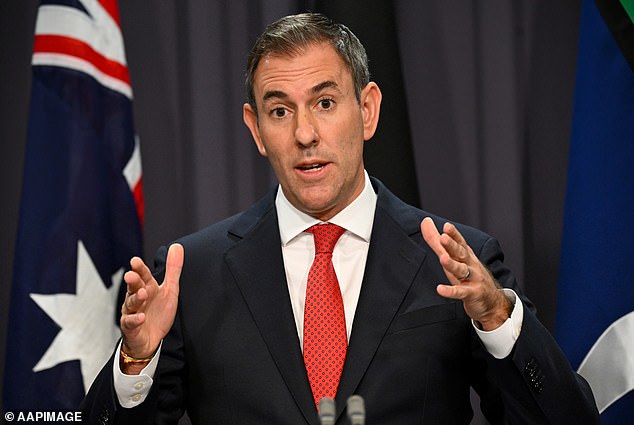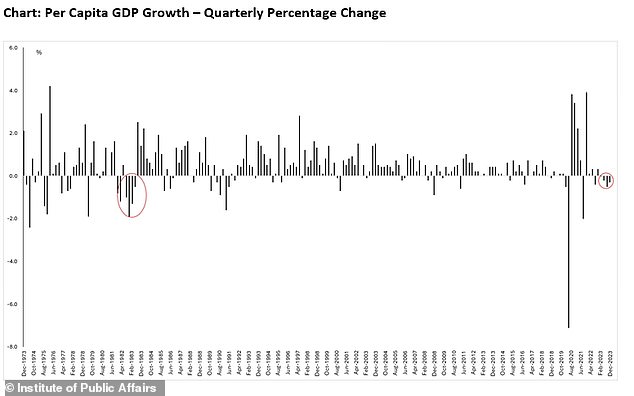<!–
<!–
<!– <!–
<!–
<!–
<!–
A worrying figure was notably absent from Jim Chalmers’ update on Australia’s “subdued” economic growth, despite it showing the worst crisis in 40 years.
The Treasurer announced on Wednesday that the economy had grown “a little bit, but not much”, reassuring the country that it was “stable”.
Official national accounts data revealed that the economy grew just 0.2 percent during the last three months of 2023 and 1.5 percent for the year, or almost half the 2.7 percent level of 2022.
But Dr Chalmers did not address how Australia is experiencing its worst per capita recession in 40 years, where output per worker has remained stable or fallen.
Falling production and productivity is bad economic news because it means that companies are producing fewer goods and services and have to pass costs on to consumers to make profits.
This poses a threat to living standards and can potentially keep inflation high for longer, delaying potential Reserve Bank rate cuts, experts have warned.

Treasurer Jim Chalmers has said nothing about Australia’s worst per capita recession in 40 years, where output per worker has been declining.
Record immigration has been blamed for Australia’s worst economic crisis in four decades.
New national accounts data showed per capita gross domestic product fell 1 percent in 2023, following a 0.3 percent fall in the December quarter.
Australia has been in a per capita recession since the March 2023 quarter, where GDP per capita has been declining.
This followed a flat result in the December 2022 quarter, where there was no growth.
National accounts data from the Australian Bureau of Statistics showed that the worst per capita recession since 1983 – the last time per capita GDP shrank or stagnated for four consecutive quarters.
But in his 864-word statement to the media, Dr. Chalmers made no mention of the per capita recession, as he acknowledged that overall economic growth was slowing.
“Today’s national accounts show Australia’s growth is moderate but stable in the face of higher interest rates, high but moderate inflation and continued global uncertainty,” he said.
‘The economy grew a little but not much. Even weak growth is welcome growth under the circumstances.’
But Institute of Public Affairs deputy director Daniel Wild said a per capita recession was a cause for concern.
“For the fourth quarter in a row, GDP per capita – a much more accurate measure of living standards than overall economic growth – has declined, meaning Australians are going backwards,” he said.
“The last time there were four consecutive quarters of decline in GDP per capita was more than 40 years ago, in 1983.


Australia has been in a per capita recession since the March 2023 quarter, where GDP per capita has been declining, marking the worst crisis since 1983 (pictured, a Sydney traffic controller).


Record immigration has been blamed for Australia’s worst economic crisis for four decades (pictured, Sydney’s Town Hall train station)
‘The decline in GDP per capita has been driven by the federal government’s unplanned mass migration program.
“Although the overall size of the economic pie is growing, Australians are left with a smaller slice.”
Productivity also fell 0.4 per cent last year, but rose 0.5 per cent in the December quarter.
AMP chief economist Shane Oliver, another critic of high immigration, noted that Australia had also suffered per capita recessions in the early 1990s, during the 2000s and on both sides of the pandemic in 2020.


Daniel Wild, deputy director of the Institute of Public Affairs, said the worst recession per capita was a cause for concern.
But he hoped the worst was over, with the Reserve Bank cash rate at a 12-year high of 4.35 per cent, following November’s 13th rise in 18 months.
‘A per capita “recession” has occurred several times in the past and, while weakness in per capita growth is negative for living standards, we expect an improvement in per capita GDP as population growth slows and GDP growth will begin to improve again later this year. – said Dr. Oliver.
A record 518,000 migrants moved to Australia in the 2022-23 financial year.
The Treasury expects that figure to fall to 375,000 in 2023-24.

